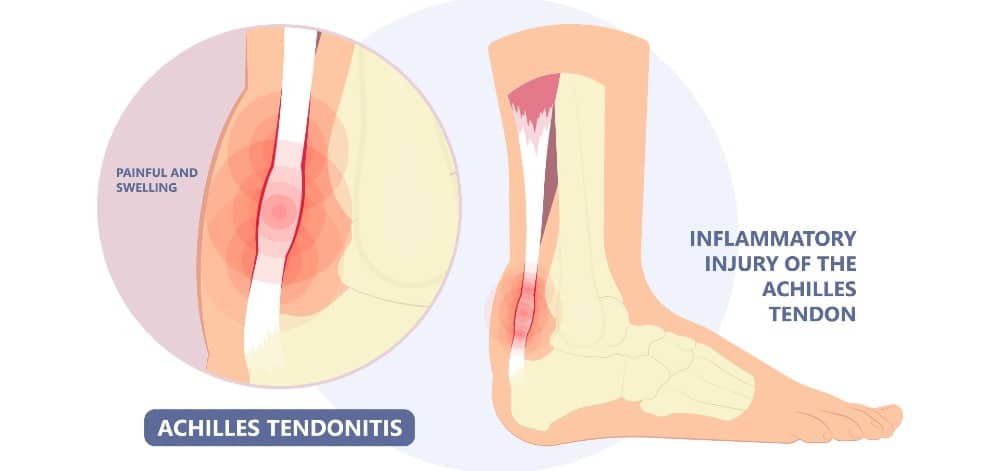What to Do When Achilles Tendinitis Strikes
Achilles tendinitis tends to be one of those problems many people are aware could potentially happen to them, but they don’t actually expect it to.
That is, of course, until it does.
If you’re starting to feel persistent pain in or around your heel, the Achilles tendinitis can certainly be the potential reason. But what is Achilles tendinitis, how do you know if you actually have it, and what should you do about it? That’s what this blog is here to cover.
Of course, any type of persistent foot or ankle pain is always something that can benefit from professional evaluation and care. If you want to skip the info and simply schedule an appointment with us right now, we’re more than happy to help you!

What is Achilles Tendinitis?
The Achilles tendon is a strong band of tissue that connects your calf muscles to your heel bone. It is the largest tendon in the body and plays a major role in our ability to walk, run, and jump well.
The Achilles tendon is built to endure a lot of force, but it is not invincible. When the tendon experiences too much stress and strain – either all at once or through repetitive motions over time – it can become aggravated, inflamed, and/or injured. That is Achilles tendinitis.
What Are the Symptoms of Achilles Tendinitis?
Pain from Achilles tendinitis tends to form either in the back of the heel or a spot just above it in the back of the leg.
This pain typically starts as a mild ache but tends to worsen after periods of repetitive tendon use, such as running or climbing stairs. Walking up hills and inclines may also cause more pain than moving on a flat surface.
Another common symptom is stiffness or tenderness in the area. This often is at its worst when getting up in the morning or after a prolonged period of inactivity, but should improve after a bit of mild movement.
In more severe cases of strain, the Achilles tendon can become torn or fully ruptured. These injuries tend to result in more sudden and severe pain, as well as a “popping” noise and trouble moving or standing on the injured leg. Always contact us or another professional right away if you believe you may have a tear or rupture.

How Does Achilles Tendinitis Happen?
Achilles tendinitis is often classified as a sports injury, and more specifically an overuse injury.
In most cases, the condition will develop due to the tendon becoming overwhelmed by repetitive activity over time. Suddenly increasing the intensity of your activities can cause excess strain, for example, as can simply having too much activity in your schedule without enough time for proper rest and recovery.
Additional factors that can contribute to Achilles tendinitis include:
- Structural abnormalities in the foot, such as flat feet, can place more strain on the Achilles.
- Having tight calf muscles, which can increase the pull on the Achilles.
- Being overweight.
- Wearing improper or supportive footwear.
- Frequently running on hilly terrain.
- Age, as the Achilles tendon can weaken over time (sorry).
- Having certain medical conditions, such as high blood pressure or psoriasis.
Treating Achilles Tendinitis
Whether you suspect Achilles tendinitis or not, a good first step for any sort of pain experienced around activity is to stop what you’re doing and begin RICE therapy.
RICE stands for:
- Rest. Try to stay off the affected leg as much as you can, and avoid activities that would strain or aggravate your Achilles tendon.
- Ice. Apply an ice pack to the area for 15-20 minutes at a time, especially after doing any exercise or experiencing pain. Always make sure to wrap the ice pack in a thin towel to avoid direct contact with the skin, which can be damaging.
- Compression. If you are confident in doing so (or know someone who is), wrap the area in an elastic bandage to help reduce swelling and keep the tendon mildly immobilized.
- Elevate. Keep the affected foot above the level of your heart whenever sitting or lying down. Prop your foot up on pillows at night while you sleep.
If you do not experience substantial improvement after 48 hours of RICE or have already been experiencing symptoms for some time, we highly recommend scheduling an appointment with us.
We will fully evaluate your condition, and likely ask you some questions about when you started feeling the pain, when it tends to feel worse, and the types of activities you enjoy doing, among others. In some cases, we might take an X-ray or other image to get a better look and rule out other potential causes of your discomfort.
Once we have a firm understanding of your tendinitis, we will recommend a plan for treatment that best suits your needs. Parts of this plan might include:
- Specific stretching and/or strengthening exercises to condition the Achilles tendon and connected tissues, such as the calf muscles.
- Changes to more accommodating and supportive footwear for your activities.
- Adjustments to your workout and activity routines, providing your Achilles a better chance to rest and recover through reduced intensities or taking on more activities that don’t place as much impact on the area.
- The use of custom orthotics to provide extra cushioning and corrective support, if needed.
- MLS laser therapy to promote pain relief and faster recovery.
- Treatment with amniotic allograft injections, which can also improve pain relief and recovery.
Surgery is rarely required to address Achilles tendinitis symptoms but might become a consideration if conservative treatments have not been effective after several months.
Find Relief and Get Back to Action
The worst thing you can do for Achilles tendinitis or any other suspected sports injury is to try to pass it off as inconsequential. The more you try to “push through” the problem and ignore it, the much higher your chances become of experiencing more pain and worse complications.
Schedule an appointment with the experts at Waco Foot & Ankle by calling (254) 776-6995 or by filling out our online contact form.
